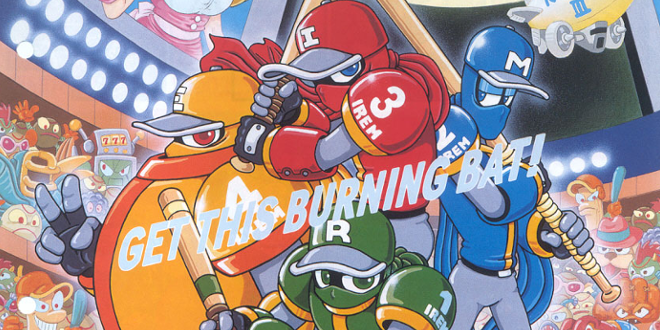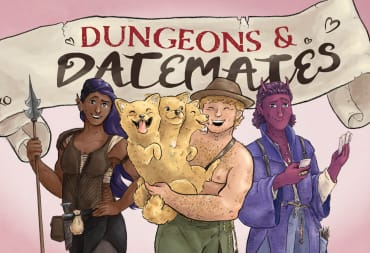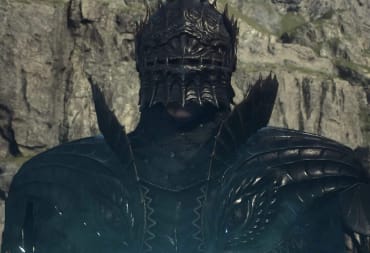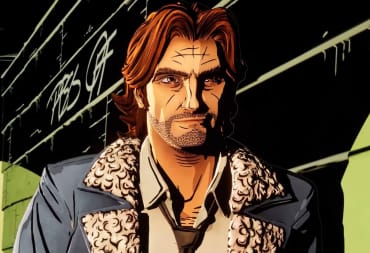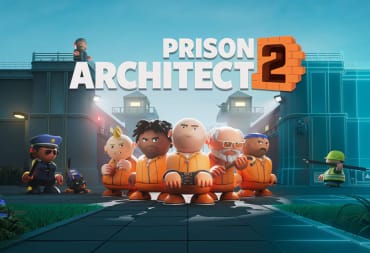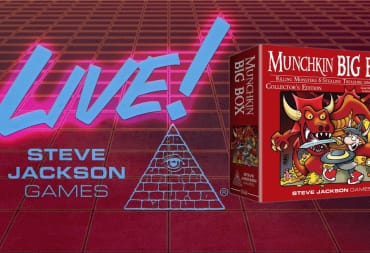Just imagine, if you will, that you are a baseball bat wielding Ninja fighting hordes of living baseballs, catcher's mitts, mafia dogs, and playing cards across the United States to collect golden baseball memorabilia stolen by a mysterious super villain who models himself after Babe Ruth.
Still with me? Good, because this is the basic plot behind Ninja Baseball Bat Man, one of the most outlandish fever dreams of a video game ever released.
I can honestly finish this editorial right here. There is not much else to say about the game's plot or premise, but there is a great story attached to the title to talk about at least. Like all obscure games, part of the reason Ninja Baseball Bat Man, at least at the time of its release, was obscure was due to limited visibility—a price paid by having the side-scrolling beat ‘em up appear only in arcades.
Out of all the markets for video games, none is more prolific yet forgotten than arcade games. Arcades are increasingly becoming a mystical unicorn in gaming culture, especially in the West. Most pure arcade places have closed down as PC, consoles, and mobile gaming have continued to dominate the market. Not only that, most arcade games today are ticket machines and games of chance over more “traditional” games.
https://www.youtube.com/watch?v=Ob1rsTsuU-k Many arcade machines have begun to fall into obscurity, with only some popular titles or franchises being remembered by the general public. Thankfully, the practice of emulation has helped in keeping arcade games relevant, as have the efforts of gaming historians, collectors, and archivists who have worked tirelessly, and in some cases illegally, to help preserve an archive of arcade games that span over 30 years.
Some games and genres will always be a constant today, most notably FPS and score chaser machines. 2-4 player beat ‘em ups, however, are a rare beast. Some games have made their way to consoles in the 1990s, such as Final Fight or Golden Axe. Others retained their popularity by sheer design or star power, such as the X-Men or The Simpsons Arcade Game. For Ninja Baseball Bat Man, the problem becomes one of exposure, despite the uniqueness of the concept behind it.
Ninja Baseball Bat Man was developed by the Irem Corporation, who was notable for developing pachinko machines and arcade games in Japan since the 1970s. Irem was a very prolific developer in the 1980s, most notably creating the R-Type series and one of the earliest beat ‘em ups in gaming, Kung Fu Master. For decades, Irem stayed active in game development, to the point where they had an international headquarters in the U.S, Irem America, which was opened in 1988.
What is most unique about Ninja Baseball Bat Man is where the concept originated, an Irem America employee by the name of Drew Maniscalco. Maniscalco worked as a National Sales Manager, and conceived of Ninja Baseball Bat Man after reading about the Teenage Mutant Ninja Turtles and Batman being among the top grossing movie releases in the early 1990s. Believing that comic-book styled heroes were in, Maniscalco thought of a comic-book hero based on a ninja, because he found the word mysterious. Being an avid baseball fan, Maniscalco gave the character a baseball theme, wearing a uniform and using bats and balls against baseball-themed enemies.
The origins behind the game were a pure marketing move, but it was one that was not unusual for video games. Infamously, the Action 52 carts for the NES, which featured 52 poorly made videogames by Action Enterprises, also had a planned superhero team that was going to get a marketing push, the Cheetahmen. Including a TV cartoon show, a comic book series, action figures and of course, the Action 52 game, the Cheetahmen have since become a symbol for bad video games worldwide, to the point of famous parody by YouTube entertainers such as James Rolfe on his show The Angry Video Game Nerd.
https://www.youtube.com/watch?v=SWXOQD-VAmY Fortunately, Maniscalco was a bit wiser in starting slow with Super Ninja Bat Man. Originally, the game was to be an adventure platformer in the vein of Super Mario Bros, but according to Maniscalco, this idea was scrapped and replaced with a side-scrolling beat ‘em up because platforming games as a coin-op adventure title would be difficult to market. Maniscalco was convinced that the idea would be a major hit on coin-op machines with this change, so with the permission of Irem America, he hired Gordon Morison, a well-known illustrator, who worked extensively on pinball machine art for the company Gottlieb, to create concept art for his idea and to help him flesh out the universe his new superhero existed in. Maniscalco would eventually create four player characters, each named after four famous baseball stars in the early 1990s, such as Jose Conseco and Daryl Strawberry, along with most of the game's bosses and enemy concepts.
All of his work was submitted to Irem Japan, who not only loved the concept behind the title, but also begun working on the production. Irem Japan added their own character concepts to the title after taking charge of the art direction, creating a more super-sentai style compared to the original, more cartoonish art design. Despite that, some of the designs created by Maniscalco, such as the boss characters, were included in the final product relatively unchanged.
Ultimately though, the game ran into some problems not in development, but in marketing. By 1992, Irem had shifted their focus on development to console games, which made coin-op arcade cabinets more of an afterthought business. While a console version of the game was discussed, it never materialized. The lack of direction, which Maniscalco points the finger to as being the game's ultimate failure, led to a low-key advertising campaign and several changes to the marketing strategy. Maniscalco decided to leave Irem America by the end of 1992 due to the shifting focus on console titles.

Ultimately, Ninja Baseball Bat Man would sell 1,042 units worldwide. Hard numbers for most arcade cabinets sold are difficult to come by, but 1,042 units is considered a moderate success in arcade gaming (for comparison-sake, the best-selling arcade game of all time, Pac-Man, had 400,000 units sold, and is one of only 6 games to achieve over 100,000 units sold worldwide.) According to Maniscalco, only 43 units would be sold in North America, making an English cabinet of Ninja Baseball Bat Man exceedingly rare. Irem itself would focus on console releases until the Tōhoku Earthquake in 2011, which would force them to cancel unfinished products and close down their software division entirely a few years later.
However, the game would find new life thanks to MAME, an emulation program that would recreate arcade games for personal use. MAME itself as a product has it's own colorful history. Created in 1997, the goal of MAME is to recreate the arcade game experience for personal computers. On one hand, MAME is important to the preservation of gaming history, a fact that the website itself has touted as the major focus for the creation of the emulator. However, while owning an emulator does not violate copyright, the problem with copyright claims on old arcade games is a major roadblock to programs such as MAME. Thankfully in 2016, MAME received an official Free Software license, meaning that players can legally download MAME and play arcade games, provided they don't try to sell the games to the public.
Ninja Baseball Bat Man would find new life through MAME, becoming quite popular due to its quirky art design and beat ‘em up gameplay. The success of the game's emulation has spurred interest in continuing the series, albeit in a non-game form by Maniscalco, who Kickstarted a short comic-book series titled Ninja Baseball Man back in 2014.
It would turn out to be a small success story for the game in the in the end. Much like any cult titles, the audience for the game has only grown since the early 2000s. Retro reviews have praised the game for its creativity, and it has also been featured in speed runs for charity, such as the SGDQ 2014 event, to raise money for Doctors without Borders. Even Rolfe, in a short video posted in 2011, praised the game in-character after joking exclaiming the game "changed his life."
It is a bit of a misnomer to call Ninja Baseball Bat Man obscure in the end, but for the general public who may be unaware of underrated arcade titles such as this, it is certainly worth talking about at the very least. Ninja Baseball Bat Man is ultimately one of the lucky ones; a relatively obscure arcade game growing in popularity and finding its audience over time. Not many arcade games can make that claim in 2016 at least, but hopefully more arcade titles get a second life in the future—after all, arcade games need to be remembered too.
I hope you guys enjoyed this article for the Gaming Obscura series. We are picking up steam and I have a lot of games on my list to talk about. Want to add to it? Please leave any comments or suggestions below or send me a tweet @LinksOcarina. See you next time.
Have a tip, or want to point out something we missed? Leave a Comment or e-mail us at tips@techraptor.net
